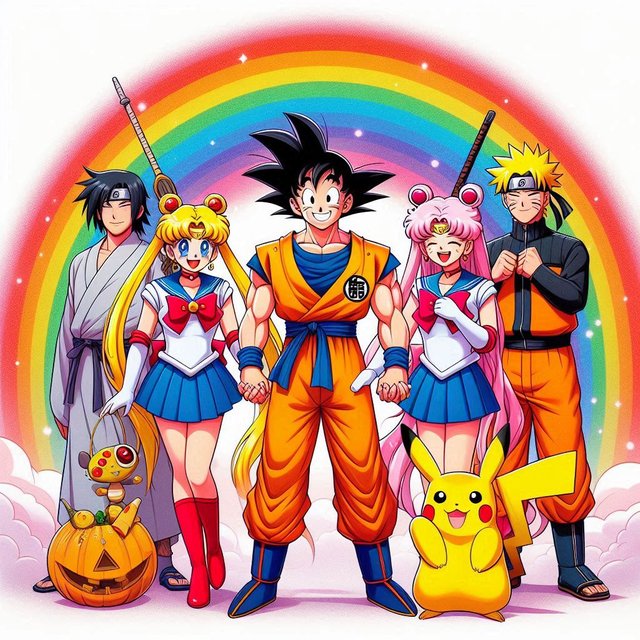Anime history
The Birth of Anime: A Historical Overview

Anime, a distinct form of animation that originated in Japan, has evolved into a global phenomenon. Known for its diverse art styles, engaging narratives, and cultural depth, anime has captured the hearts of audiences worldwide. But to fully appreciate the world of anime, it’s essential to explore its origins and the key events that shaped its development.
Early Beginnings: Influence of Western Animation
The roots of anime can be traced back to the early 20th century, when Japan was heavily influenced by Western media, including films and animation. During the 1910s and 1920s, Western animated films such as those created by Disney and Fleischer Studios were imported to Japan, inspiring Japanese filmmakers to experiment with the new art form.
The first known instance of Japanese animation is Namakura Gatana (1917), a silent short film created by Jun'ichi Kōuchi, considered one of the pioneers of early Japanese animation. Alongside Kōuchi, other notable animators like Seitaro Kitayama and Ōten Shimokawa played key roles in developing what would later be recognized as anime. These early works were often very short, silent, and hand-drawn, laying the groundwork for the future industry.
World War II and Post-War Animation
The 1930s and 1940s marked a period of political propaganda in Japan, and animation was used as a tool to promote nationalistic messages. During World War II, the Japanese government commissioned several animated films, including Momotaro: Umi no Shinpei (1945), a feature-length film directed by Mitsuyo Seo. This film, designed to boost morale among Japanese citizens and soldiers, was influenced by Walt Disney’s Fantasia and other American animated features.
After World War II, Japan was in a state of economic hardship, but the animation industry began to recover. The rise of television in the 1950s and 1960s opened new opportunities for animators, and the industry slowly started shifting from short films to serialized television shows.
The Emergence of Osamu Tezuka: The Godfather of Anime
One of the most influential figures in the development of anime was Osamu Tezuka, a manga artist often referred to as the "Godfather of Anime." Tezuka’s work was heavily influenced by Disney animations, and he played a pivotal role in shaping modern anime’s visual and storytelling style. His revolutionary manga series Astro Boy (originally Tetsuwan Atom) was adapted into a television anime in 1963, becoming Japan’s first successful animated TV series.
Tezuka’s animation style was characterized by exaggerated emotions, large expressive eyes, and a focus on compelling narratives—traits that would become hallmarks of the anime genre. Astro Boy was a massive success both in Japan and internationally, marking the beginning of anime’s rise as a commercial and cultural force.
The Golden Age of Anime: 1970s and 1980s
The 1970s saw the emergence of new anime genres and styles. Studios like Toei Animation and Tatsunoko Production gained prominence during this era. Mecha anime, a genre centered on giant robots, became particularly popular with shows like Mazinger Z (1972) by Go Nagai. This genre would later evolve with the release of Mobile Suit Gundam (1979), a groundbreaking series that blended political intrigue, realistic characters, and giant robot battles.
The 1980s is often considered the "Golden Age of Anime." During this period, anime gained widespread popularity both in Japan and overseas, thanks to the development of original content for both television and film. Hayao Miyazaki and Isao Takahata co-founded Studio Ghibli in 1985, producing critically acclaimed films such as Nausicaä of the Valley of the Wind (1984) and My Neighbor Totoro (1988). Their films introduced a new level of artistic sophistication and emotional depth to anime.
In addition, the release of Akira (1988), directed by Katsuhiro Otomo, was a landmark moment. Akira brought cyberpunk aesthetics and mature storytelling to the forefront, demonstrating anime’s potential for addressing complex social issues and philosophical themes. It helped solidify anime’s place in the global market, particularly in the West.
Modern Anime: 1990s to Today
The 1990s saw continued growth in the anime industry, with iconic series like Neon Genesis Evangelion (1995), which redefined the mecha genre with its psychological depth and complex narrative, and Pokémon (1997), which became a worldwide cultural phenomenon.
By the 2000s, anime had fully entered the mainstream, aided by technological advances and the internet. Streaming services like Crunchyroll and Netflix allowed international audiences to access a wide range of anime, from slice-of-life series to epic fantasy sagas. Films like Spirited Away (2001), directed by Miyazaki, won international awards, including an Academy Award, further solidifying anime's global influence.
Conclusion: A Lasting Legacy
Anime has grown from its early experimental days into a globally recognized and respected form of entertainment and art. From the pioneering work of Osamu Tezuka to the global influence of Studio Ghibli, anime’s evolution reflects a unique blend of Japanese culture, creativity, and innovation. Today, anime continues to evolve, captivating new generations of fans with its distinct storytelling, artistic expression, and universal themes. As the medium continues to expand and diversify, its impact on global pop culture remains undeniable.